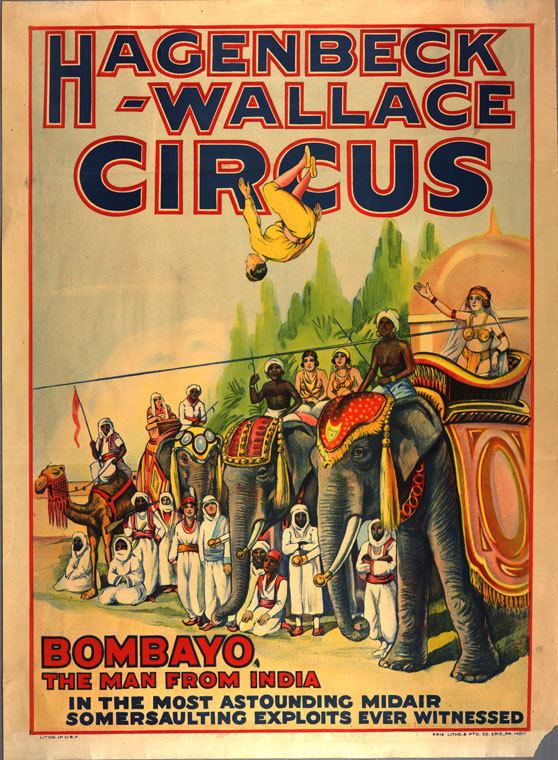Country United States | Operator(s) Benjamin Wallace | |
 | ||
Circus name Hagenbeck-Wallace Circus Founder(s) Carl Hagenbeck – Carl Hagenbeck Circus in 1903
Benjamin Wallace – The Great Wallace Show in 1884 Year founded Formed in 1907 when Wallace purchased the Carl Hagenbeck Circus and merged it with his circus. Fate Ceased operations in 1938. | ||
The Hagenbeck-Wallace Circus was a circus that traveled across America in the early part of the 20th century. At its peak, it was the second-largest circus in America next to Ringling Brothers and Barnum and Bailey Circus. It was based in Peru, Indiana.
Contents
History
The circus began as the “Carl Hagenbeck Circus” by Carl Hagenbeck (1844–1913). Hagenbeck was an animal trainer who pioneered the use of rewards-based animal training as opposed to fear-based training.
Meanwhile, Benjamin Wallace, a livery stable owner from Peru, Indiana, and his business partner, James Anderson, bought a circus in 1884 and created "The Great Wallace Show". The show gained some prominence when their copyright for advertising posters was upheld by the Supreme Court in Bleistein v. Donaldson Lithographing Company. Wallace bought out his partner in 1890 and formed the "B. E. Wallace Circus".
In 1907, Wallace purchased the Carl Hagenbeck Circus and merged it with his circus. The circus became known as the Hagenbeck-Wallace circus at that time, even though Carl Hagenbeck protested. He sued to prohibit the use of his name but lost in court.
In 1913, the circus lost 8 elephants, 21 lions and tigers and 8 performing horses in the Wabash River flood. That same year, Wallace sold his interest in the circus to Ed Ballard of French Lick, Indiana.
Another tragedy struck the circus before 4:00 a.m. on June 22, 1918, in the Hammond Circus Train Wreck when a locomotive engineer fell asleep and ran his empty troop train into the rear of the Hagenbeck-Wallace circus train near Hammond, Indiana. A fire broke out from the kerosene lamps, which were used for lighting in the sleeping cars of the circus train. The fire quickly spread through the wood-constructed cars. As a result of the collision and subsequent fire, 86 persons died and another 127 were injured. Many victims were burned beyond recognition. Most are buried in Woodlawn Cemetery in Forest Park, Illinois in a section set aside as Showmen's Rest.
In the spirit of "the show must go on", several competing circuses, including Ringling Brothers and Barnum & Bailey, lent equipment and performers to Hagenbeck-Wallace so that only two performances were canceled as a result of the tragedy, the one in Hammond and the next stop in Monroe, Wisconsin. After the tragedy, circus entrepreneurs Jeremiah Mugivan and Bert Bowers acquired Hagenbeck-Wallace Circus, adding it to a long list of circuses they owned, including Sells-Floto Circus and John Robinson Shows. Mugivan was the chief operations man. A year later, Mugivan and Bowers asked Ballard to join them and the trio formed the American Circus Company.
The successor company of the American Circus Corporation was sold by Jeremiah Mugivan, Bert Bowers and Ed Ballard to John Nicholas Ringling of Ringling Brothers and Barnum & Bailey in 1929 for $1.7 million (US$ 23,700,000 in 2017), along with Al G. Barnes Circus, Sells-Floto Circus, John Robinson Shows, and Sparks Circus.
The circus spent its winters just outside Baldwin Park, California. There, on 35 acres of land, the circus stayed with its huge parade wagons parked alongside a railroad spur. The elephants spent time hauling refuse wagons, shunting railroad cars and piling baled hay. A tent at the eastern edge of the grounds was used by aerialists to practice trapeze and high-wire acts. The circus usually remained there from late November to early spring.
The Great Depression and Ringling's ill health caused the Ringling empire to falter. In 1935, the circus split from Ringling Brothers and Barnum & Bailey and became the Hagenbeck-Wallace and Forepaugh-Sells Bros. Circus. It finally ceased operations in 1938.
The complex near Peru that formerly housed the winter home of Hagenbeck-Wallace now serves as the home of the Circus Hall of Fame.
In fiction
The Hagenbeck-Wallace Circus was the inspiration for the novel The Circus in Winter by Cathy Day. The book is about the fictional "Great Porter Circus", which made its winter home in the "Lima, Indiana", which stood in for the author's home town of Peru, Indiana. The author is the great-niece of an elephant trainer of the Hagenbeck-Wallace Circus. Hagenbeck's name also appears in a series of Polish books for teenagers by Alfred Szklarski. The main characters from the books travel around the world to hunt animals for Hagenbeck's circus.
Hagenbeck is also mentioned in the story "Premier amour" of Samuel Beckett as a well known lion tamer, who is buried in the Ohlsdorf Cemetery and is briefly mentioned in Water for Elephants.
In the fall of 2006 The Neo-Futurists theater company of Chicago mounted an original production entitled Roustabout: The Great Circus Train Wreck! based on the Hagenbeck-Wallace Circus. The play was written by Jay Torrence and directed by Torrence and Kristie Koehler. The show was remounted by the Neo-Futurists in the summer of 2007 at the Chicago Park District's Theater on the Lake.
In the spring of 2013 Concordia University Chicago put on a play titled "Roustabout! The Great Circus Train Wreck" focused on the train wreck of 1918.
